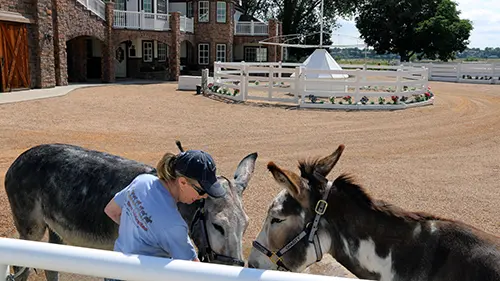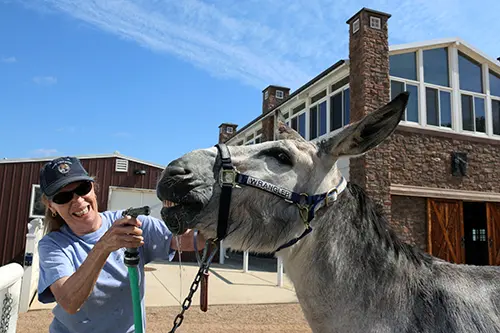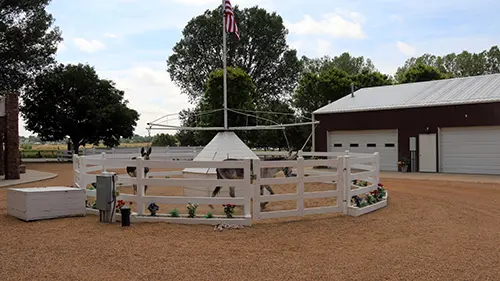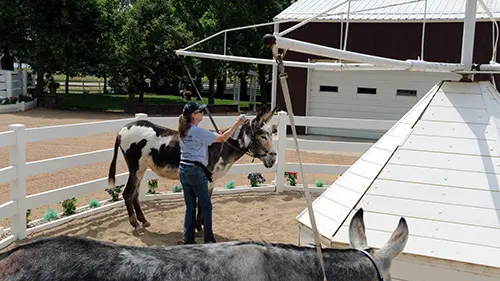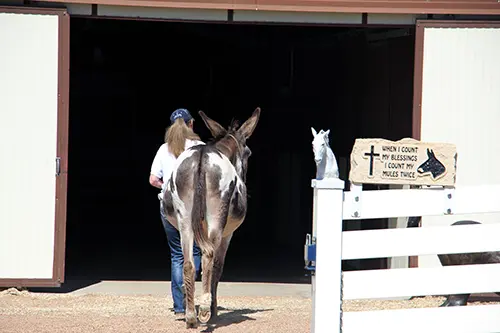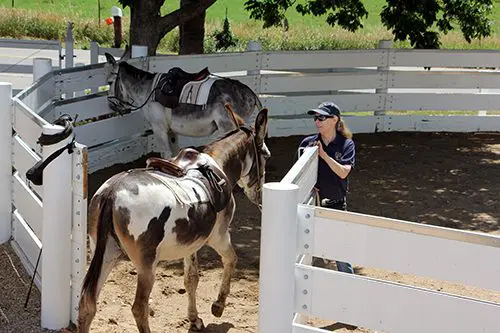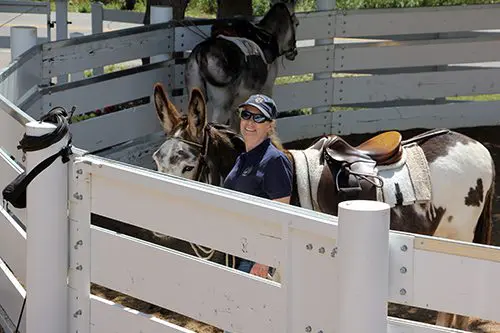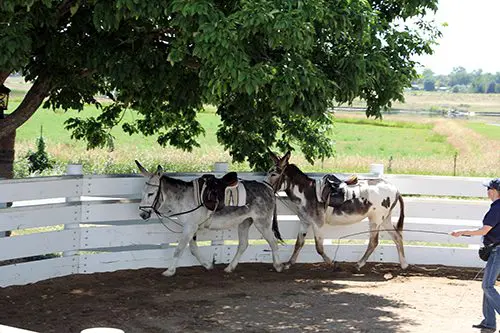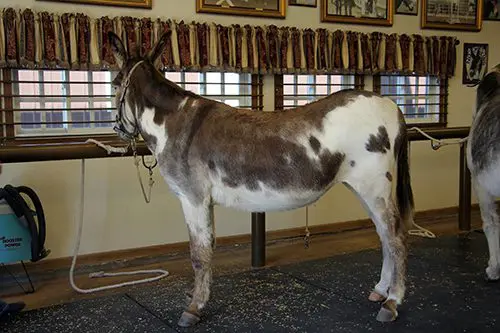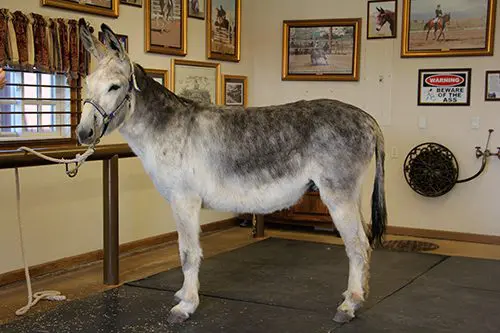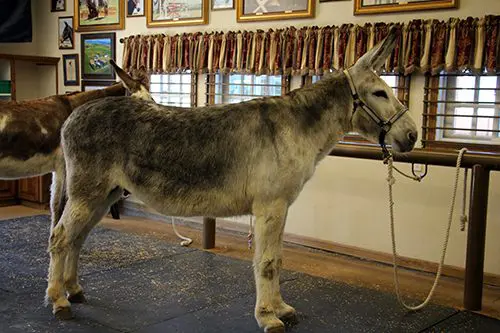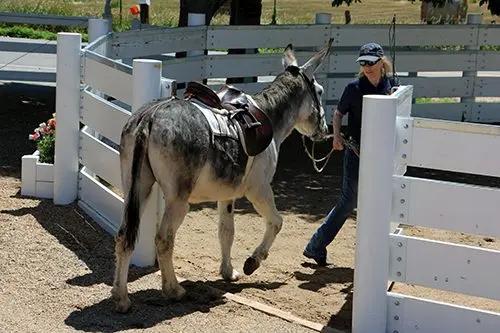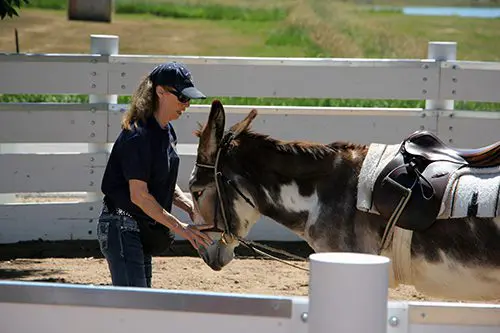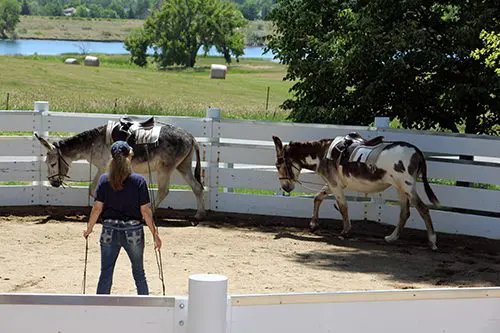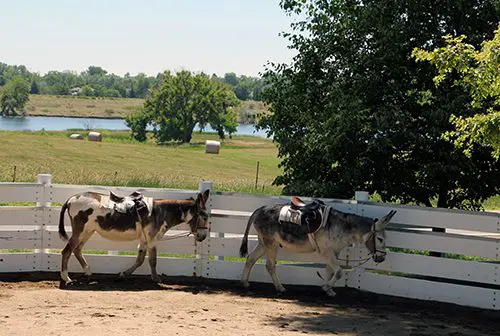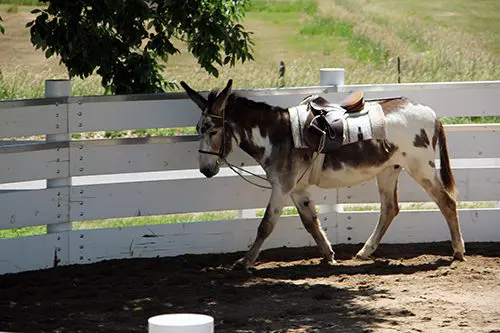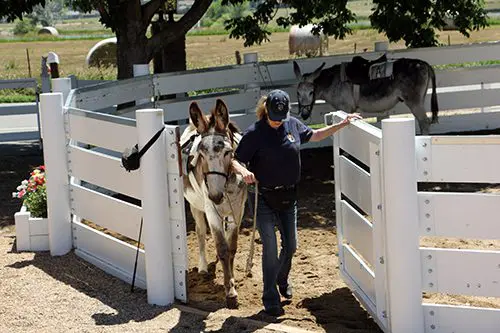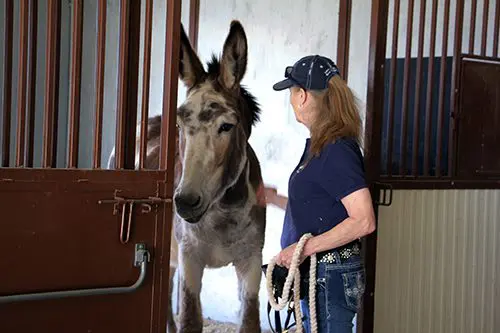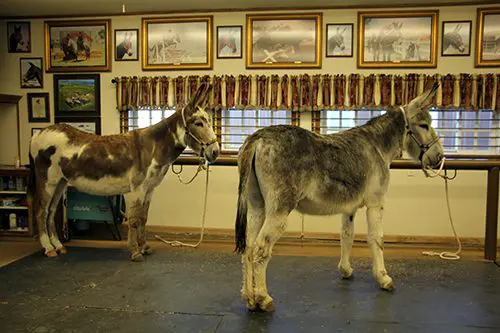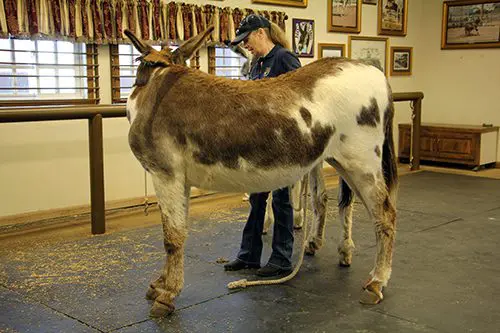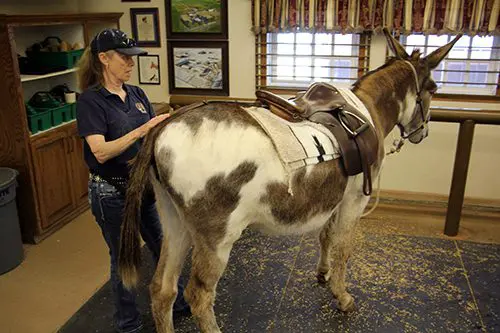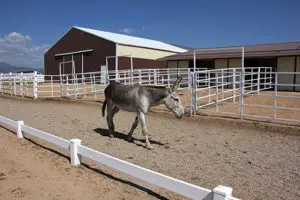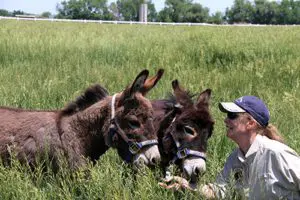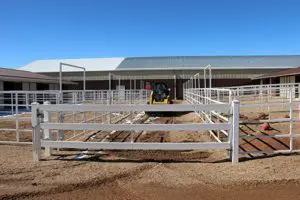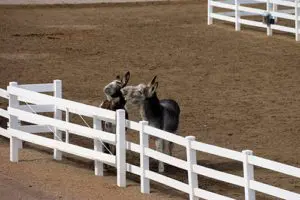
Chasity’s Challenges


CHASITY’S CHALLENGES: Real Time Update: 5-5-20
5-5-20: My Grandmother taught me that Good Posture, Good Manners and Good Hygiene don’t cost anything but very little time and effort, and the results are nothing less than miraculous! Practicing these simple elements of living can, however, save you a lot of money in veterinary and maintenance costs associated with you and your equines! Preventive measures can deter accidents and good hygiene practices deter poor health. Chasity came to us with a plethora of problems. I have documented and shared a number of things with you about the benefits of postural core strength development that I used with a number of equines here at my ranch. This time, I am documenting this approach with even more details than I ever have before so you can see the types of things that I do from feeding to maintenance to exercise that bring about these amazing results! I will be posting “CHASITY’S CHALLENGES” on the weekends with occasional “real time” updates. Today, we have had Chasity for a month. She came in with very bad equine posture, cataracts in both eyes, Lordosis in her spine (sway-back), fatty deposits over her body and an enlarged, fatty neck crest, overgrown and unbalanced hooves, and a major bacterial infection in her badly swollen teats and udder. Today, the posture is significantly better and the Lordosis is receding, the body fat deposits are gone and the crest is shrunk by 50%, her hooves are balanced and staying that way and the bacterial infection in her teats and udder has been reduced by 70%. When she came in, she was introverted, head shy and was hesitant to engage with us. Today, she is no longer head shy (She “trusts” even though she cannot see very well) and is a happy and willing companion! PHOTO #1 – 3-31-20; PHOTO #2 – 5-5-20; PHOTO #3 – 3-30-20; PHOTO #4 – 5-5-20. Check the CHASITY’S CHALLENGES posts each weekend for lots more details!

3-31-20

5-5-20

3-30-20

5-5-20

CHASITY’S CHALLENGES: Fun with Friends: 8-4-20
Donkeys love it when you keep things easy, fresh and interesting! Chasity has been doing so well with her lessons with Wrangler lately that I thought we could change things up a bit and add a LITTLE excitement to their routine by adding the mini donkeys, Augie and Spuds! If this is to be a safe endeavor, I will have to break things down into small introductory steps and make frequent evaluations as to what is safe to do and what might not be safe. I want them all to enjoy this time together with me! Seeing the mini donkeys in the Tack barn work station, Chasity is getting already started with a smile on her face!
First, I lunged Chasity by herself to see how she would respond in her “Elbow Pull” and to see whether she would maintain her good postural balance during this lesson. She did lovely at an energized and forward working walk! I was very pleased.
Chasity then bucked up her working trot and although she raised her head just a bit, she kept the “Elbow Pull” loose almost all the time…she is truly improving rapidly!
Next, I ground drove her and again, she did everything just right and maintained her good posture and balance…through the reverses and in both directions!
Chasity’s contact with my hands was steady and light, and she easily did her “S” turns through the middle of the Round Pen gracefully and accurately.
Chasity did a square halt and did the rein back much more easily that she had in prior lessons. She is making marked improvement every week! Yes, we only do these lessons once a week for about 20-30 minutes to get these amazing results!
Chasity and Wrangler always enjoy lunging together, but sometimes he will get a bit slow and cause her to raise her head behind him and put more tension on the “Elbow Pull” than she would do if he was not there. Wrangler spotted Augie and Spuds tied outside and did not want Chasity anywhere near them! That was when I made the decision that now would not be the right time to lunge FOUR donkeys together!
Instead, I tied Wrangler outside and introduced Chasity to Augie and Spuds…they liked each other, so I began lunging them all together! Chasity loved it!
The donkeys, large and small, tracked left and then did a perfect halt…all three of them! As they stood stock still, I rewarded them each one for a job well done!
Chasity surprised me by doing a perfect reverse and then walked behind Augie and Spuds to show them the new direction. Then they too, reversed and followed her obediently! I had to chuckle…who’s in charge here?! Wrangler just hid his face behind the post outside of the Round Pen, hoping no one would notice how left out he felt! Even though Wrangler was a bit miffed, they all had a very good time! At least he was not completely left out! Friends really LIKE to work together!

CHASITY’S CHALLENGES: Yearly Baths: 7-14-20
Each year, I try to pick the hottest week in July to do the equine’s yearly baths. The mules and horses have shed out their winter coats, except for a strip of hair on the mules’ bellies, and the donkeys are getting closer to being completely shed out. This makes a difference when you are trying to get them dry after their baths. They all begin to grow their winter coats in September.
Their natural hair coats will insulate them from the heat and cold and will protect them from insects, so I do not advise clipping them unless you are showing. Even then, it is not advisable to clip the hair inside of the ears! I bath as many as four at a time and in smaller friendly groups like Wrangler and his “Lady Love,” Chasity! I am polite, considerate and respectful, so it is always an enjoyable experience for all! I begin with the introduction to the hose on their front legs.
Wrangler and Chasity enjoy their yearly baths to get off the dirt that has built up during the year. I offer a drink to their lips and afterwards move to their foreheads, being careful not to get water in their eyes or ears. I spray the water gently into their mouths and we “water pick” the teeth! Playful antics like this teach them to always remain calm and keep things safe between us. This keeps interest to a maximum and intimidation to a minimum.
When they are approached in this manner, Chasity and Wrangler can enjoy the cool water on a hot day! Chasity knows I am being careful and doesn’t pull away, then takes a sip from the hose.
I reward Chasity with crimped oats from my fanny pack for being such a good girl. Then I rinse off the oats that were stuck to her whiskers as she gazes at the other equines in the pens nearby who are anxiously awaiting their turns.
Her attention returns to me and I work my way up her forehead to her forelock and ears. I make sure the spray is light and doesn’t sting so she will keep her ears laid back for the rinsing. I would hate to get water in Chasity’s ears, but if by accident I do, I just back off and allow her to shake her head to get the water out before I resume.
We use Tres Semme (Breakage Defense) shampoo and Aussie 3X Conditioner on the manes and tails only, and just water on their bodies to keep their hair coats from drying out. In the case of Chasity’s white legs, I will use the shampoo and conditioner there, too. The result is a healthy and shiny hair coat year round.
I spray the water over their bodies and then follow up with the serrated side of the shedding blade to scrape the dirt from their body. I keep going over each spot until the water runs clear. I pay special attention to the legs and any places that flies might have laid eggs. I will scrape these places with a stiff brush or with my fingernails and apply Neosporin to these spots, and any sores, after they are dry. I scrape off the excess water with the smooth side of the shedding blade. Then Chasity and Wrangler are put on the hot walker to dry.
When Wrangler and Chasity are dry, I sprinkle Johnson’s Baby oil in the manes and tails and spray for flies with Farnam Tri-Tech 14. The baby oil will keep them from chewing on each other’s manes and tails. Those who have sensitive skin around their eyes will receive fly masks. Chasity and Wrangler do not need them. When entering or leaving an area, we ALWAYS execute gates exactly the same way! That way, there is no confusion and chaos that could result in resistant behaviors.
Chasity and all my equines always know exactly what is expected and know exactly what they need to do.
Chasity will be rewarded with her favorite crimped oats for her cooperative behavior. Good manners, and being polite and respectful are paramount to getting your equine’s full cooperation! Even if Chasity does go right out into her pen and roll afterwards, she always seems to enjoy having clean, healthy skin and hair. And, most of all, she enjoys her time with me and looks forward to the next time!

CHASITY’S CHALLENGES: Yearly Baths: 7-14-20
Each year, I try to pick the hottest week in July to do the equine’s yearly baths. The mules and horses have shed out their winter coats, except for a strip of hair on the mules’ bellies, and the donkeys are getting closer to being completely shed out. This makes a difference when you are trying to get them dry after their baths. They all begin to grow their winter coats in September.
Their natural hair coats will insulate them from the heat and cold and will protect them from insects, so I do not advise clipping them unless you are showing. Even then, it is not advisable to clip the hair inside of the ears! I bath as many as four at a time and in smaller friendly groups like Wrangler and his “Lady Love,” Chasity! I am polite, considerate and respectful, so it is always an enjoyable experience for all! I begin with the introduction to the hose on their front legs.
Wrangler and Chasity enjoy their yearly baths to get off the dirt that has built up during the year. I offer a drink to their lips and afterwards move to their foreheads, being careful not to get water in their eyes or ears. I spray the water gently into their mouths and we “water pick” the teeth! Playful antics like this teach them to always remain calm and keep things safe between us. This keeps interest to a maximum and intimidation to a minimum.
When they are approached in this manner, Chasity and Wrangler can enjoy the cool water on a hot day! Chasity knows I am being careful and doesn’t pull away, then takes a sip from the hose.
I reward Chasity with crimped oats from my fanny pack for being such a good girl. Then I rinse off the oats that were stuck to her whiskers as she gazes at the other equines in the pens nearby who are anxiously awaiting their turns.
Her attention returns to me and I work my way up her forehead to her forelock and ears. I make sure the spray is light and doesn’t sting so she will keep her ears laid back for the rinsing. I would hate to get water in Chasity’s ears, but if by accident I do, I just back off and allow her to shake her head to get the water out before I resume.
We use Tres Semme (Breakage Defense) shampoo and Aussie 3X Conditioner on the manes and tails only, and just water on their bodies to keep their hair coats from drying out. In the case of Chasity’s white legs, I will use the shampoo and conditioner there, too. The result is a healthy and shiny hair coat year round.
I spray the water over their bodies and then follow up with the serrated side of the shedding blade to scrape the dirt from their body. I keep going over each spot until the water runs clear. I pay special attention to the legs and any places that flies might have laid eggs. I will scrape these places with a stiff brush or with my fingernails and apply Neosporin to these spots, and any sores, after they are dry. I scrape off the excess water with the smooth side of the shedding blade. Then Chasity and Wrangler are put on the hot walker to dry.
When Wrangler and Chasity are dry, I sprinkle Johnson’s Baby oil in the manes and tails and spray for flies with Farnam Tri-Tech 14. The baby oil will keep them from chewing on each other’s manes and tails. Those who have sensitive skin around their eyes will receive fly masks. Chasity and Wrangler do not need them. When entering or leaving an area, we ALWAYS execute gates exactly the same way! That way, there is no confusion and chaos that could result in resistant behaviors.
Chasity and all my equines always know exactly what is expected and know exactly what they need to do.
Chasity will be rewarded with her favorite crimped oats for her cooperative behavior. Good manners, and being polite and respectful are paramount to getting your equine’s full cooperation! Even if Chasity does go right out into her pen and roll afterwards, she always seems to enjoy having clean, healthy skin and hair. And, most of all, she enjoys her time with me and looks forward to the next time!

CHASITY’S CHALLENGES: Ground Driving Chasity: 7-7-20
Chasity continues to improve. We have cut the size of her obese, cresty neck by 70%. Her back is finally elevated. The spinal and abdominal muscles are much better conditioned and support her good posture. She has come a long way. She is submissive to the “Elbow Pull” and ready to begin her combination exercises in Lunging and Ground Driving. Chasity is happy that she gets to do these exercises with her “boyfriend,” Wrangler! He is her inspiration. They are so funny together!
Chasity executes the gate perfectly and then stops to pose for a picture with me. Then we adjust her “Elbow Pull” and make sure she flexes at the poll to submit. This self-correcting restraint will provide resistance if she tries to carry her head too high which would result in hollowing her neck and back, and thus, compromising her good equine posture.
Once everything is adjusted on Chasity and Wrangler, we pose for a picture. Then they both go obediently to the rail and begin work at the walk. I have added the reins to Wrangler’s bridle to keep him from carrying his head too low. That is not an issue with Chasity. It is not usually a problem with with Wrangler either, but it is in the nineties today and very hot. Wrangler gets very lazy in the heat!
They are both stepping out nicely and exhibiting a pretty fair “working walk.” After five rotations at the walk, I ask for the trot. They are both stepping well underneath their centers of gravity and Chasity is submitting to the pressure from the “Elbow Pull.” This means she is in better equine posture with improving self-carriage.
After five rotations at the trot, I ask them for a halt and they are prompt in their response. They are rewarded and then proceed forward and after one rotation, I ask them to reverse. It is the best reverse yet!
I am so proud of Chasity! She is really holding her good posture nicely for prolonged periods of time now, even at the trot!
Chasity is gaining a lot of core strength and power to her gaits. The halts are mostly square on the landing and do not need to be corrected. Chasity is finally learning to use her hindquarters properly and she is no longer getting locked up in the right hip joint. It is now adequately supported symmetrically by the core elements: muscles, tendons, ligaments and soft tissue. Her joints operate correctly and will not wear irregularly.
After five rotations at walk and then trot in the opposite direction, Chasity was finally ready for her first Ground Driving lesson! When asked, she walked off nicely.
I had Ground Driven Wrangler first, so Chasity got to see what this was all about. She submitted softly to the lines and remained “on the bit” as we walked along. She turned easily when asked to do the “S” turn through the middle of the Round Pen.
But suddenly, we had a “Donkey Moment” when she abruptly bolted toward Wrangler! I let the lines slide through my hands, hoping she would slow down…but she didn’t! I dug my heels into the ground to try to stop her, holding the lines with just one hand so I wouldn’t lose my balance. Wrangler just dropped in behind her at the walk.
Chasity was at a fast trot around Wrangler when he decided to help me by leaning his body into the lines. This put more pressure on her bit and helped me to get her slowed down…Thanks, Wrangler!!!
Once she had slowed down, Wrangler moved away and allowed me to turn her into the rail and ask for a reverse to the right. Chasity calmed down immediately and decided to comply with my wishes… thankfully!
Chasity was still full of energy, but submitted to the pressure on the lines as I walked behind her in sync with her hind legs. I slowly crept back up the lines with my hands and got a bit closer to her hindquarters
Then I asked Chasity for the halt and a few steps of the reinback…not too many steps at first. I rewarded her efforts with a handful of crimped oats. Her first time on the drive lines had gone very well indeed… even WITH the “Donkey Moment!” It’s always good to keep your sense of humor when working with donkeys and be ready to be VERY patient! Donkeys need to process things THEIR WAY!

CHASITY’S CHALLENGES: Learning to Submit to the “Elbow Pull”: 6-23-20
Chasity has made marked improvement in the past two weeks with her work in the Round Pen with Wrangler. They really enjoy working together and always give me their very best effort! Their bodies are really improving with the work even though their lessons are only once a week! Chasity’s infection is completely gone, her Lordosis (sway back) is no longer there and the fat on her neck crest has shrunk significantly. It will still take a very long time to get it down to where it should be. There is simply no quick way to do this that would still be healthy for her, but she has come a LONG WAY already!
Although Wrangler is still sporting some belly hair that makes his torso look thick, both donkeys are at optimum health and weight. It is June so they have not yet shed their coats completely. Still, their hair coats are healthy and soft due to their diet and weekly grooming. I use a plastic human multi-bristled hair brush with a sprinkle of Johnson’s Baby Oil in the manes and tails for hair protection and to keep them from chewing on each other’s manes and tails. The weekly grooming with the hairbrush aerates the coat and keeps the hair healthy. They can then shed all the dead hair and not just what is on top. It also prevents breakage and uneven growth. I never body clip unless they are showing and never do the insides of the ears. Their hair coats insulate them from the heat and cold, and protect them from insects when the hair is properly maintained. They will be fully shded by August and grow their winter hair in September.
Wrangler is taken to the Round Pen first and executes the gate perfectly! I always do gates exactly the same way and reward so all my equines know what to expect and can behave accordingly with no fuss.
I tie Wrangler with the “Elbow Pull” and then go to get Chasity. She also executes the gate perfectly while Wrangler waits patiently! When you do things in a way that they always know what to expect next, there is no anxiety and therefore, no need for a “Patience Pole” to teach them to stand quietly.
I then adjusted Chasity’s “Elbow Pull” such that she has plenty of slack to raise her head, but not enough to raise it so high that she inverts her neck and back. If she tires during the lesson, she can lean against it without sacrificing her good equine posture until she can regain self-carriage again. It will put pressure on the poll, bit rings, forearms and back when she leans on and will be taut (but not tight) and when she is in total self-carriage, it will remain loose. It is a similar concept as a ballet dancer using their balance bar.
We posed for a picture before I adjusted Wrangler’s “Elbow Pull.” I allow those who already have consistent self-carriage a lot more slack than I do those who are first starting out.
Wrangler is carrying his head and neck a bit low today, but I believe he is just stretching his back that probably got sore from his antics in the larger pen yesterday when he was first turned out with Chasity! Simply put, he played a bit too hard! Chasity is starting to carry her own good posture much better and is not leaning on the “Elbow Pull” as much as she did just two weeks ago!
They each took their turn and executed very nice reverses when asked…first Chasity and then Wrangler! People often have problems lunging their donkeys, but taking things slowly and in the right logical sequence seems to help a lot! I am also grateful that I have one senior donkey to help me teach the “newbie.” It saves a lot of running and encouragement with the whip. And, they enjoy working together a lot more than alone!
Chasity really has her good posture down nicely and is keeping the “Elbow Pull” loose during the five rotations at walk in each direction. This direction, she really got enthusiastically engaged at the trot and only slightly leaned on her “Elbow Pull.” I could have taken up the slack on Wrangler’s “Elbow Pull” for this trot rotation and he would have done better, but he wasn’t excessively bad so I opted no to do it.
I did one more extra lap at a good working walk and Chasity showed me her BEST posture! I am so pleased with her improvement and so is she!!! Wrangler waits patiently for his turn to go back to the work station in the Tack Barn. What great donkeys they are!

CHASITY’S CHALLENGES: Lunging Together: 6-10-20
Chasity had no way of knowing that she was about to graduate from the Hourglass Pattern to the Round Pen today, nor did she really care! She knows that every experience with me is happy and rewarding! So, she was waiting patiently at the stall door for me to come get her after I had already gotten Wrangler, her beau, from his stall! She put on her “happy face” and proceeded to the Tack Barn with a spring in her step!!!
She was particularly happy to see Wrangler standing at the work station! I cleaned both of their eyes, ears and nostrils with no problem at all! They were both eager to find out what was coming next!
After her initial introduction to the “monster vac,” this time she did not even bat an eyelash! It was of no consequence to her anymore…she was BRAVE now! I rewarded her and marveled at how her neck was improving! The fat was disappearing and her neckline was becoming straighter. Hallelujah!
I asked Chasity to do her stretches first to the right and then to the left. Her response was becoming much more flexible and symmetrical on both sides.
The Courbette (on Chasity) and the Passier (on Wrangler) are two used All Purpose English saddles that I bought over 35 years ago, that fit all my mules and donkeys, and are in as good condition today as the day that I bought them! I centered them on their backs and adjusted the crupper to keep them in place!
I bridled them both and took Wrangler to the Round Pen first. Then I tied Chasity on the outside of the Round Pen and she watched while I lunged Wrangler.
Then it was her turn! I adjusted the “Elbow Pull” self-correcting restraint to the right tension and asked Chasity to flex at the poll. Then we began lunging. She leaned on the “Elbow Pull,” but it kept her from hollowing her back and neck while still allowing her to reach well underneath her body with her hind legs.
After five rotations in one direction, I stopped her and asked for a reverse. She hesitated, but eventually understood what I was asking of her and happily trotted off. She did make me work a bit to keep her going, but she was beginning to relieve a bit of the tension on the “Elbow Pull.”
Since things were going so well, I rewarded Chasity and flexed her neck again. I decided to allow Wrangler to help show her how it is done for five more rotations in each direction. That would be all I would need to do on a 85+ degree day with their shedding not quite completed. Wrangler was amazing! They had not been turned out together yet, so I thought he might be silly with her, but he was all business!
Of course, Wrangler did the reverse quickly and perfectly while Chasity took a little persuading. Wrangler just walked confidently and patiently, keeping his good posture with the “Elbow Pull” loose, while he waited for her to catch up. For two thirteen year olds, they were awesome!
Although Wrangler has been with me for three years, and Chasity for only three months, I find it amazing how quickly they happily come to their ideal equine posture. They exit their lessons renewed and refreshed!

CHASITY’S CHALLENGES: Stretching the Spine for Optimum Flexibility: 5-5-20
5-5-20
Chasity was very stiff and compromised through her whole body when she first arrived. She was extremely rigid over the top line and could not flex from the poll at all, much less through her entire spine. The “Elbow Pull” self-correcting restraint and work in the Hourglass pattern has helped her to be more flexible in her head and neck, and has produced some flexion through her back. Now we are going to ask her to extend that flexion the whole length of her spine. She has been learning how to stay erect around turns while bending through her rib cage, and easily flexes her neck and back when squared up at the halt. These subtle actions have reshaped the body fat evenly over her body and reduced the size of her enlarged neck by 50% in just one month! Her posture is already greatly improved!
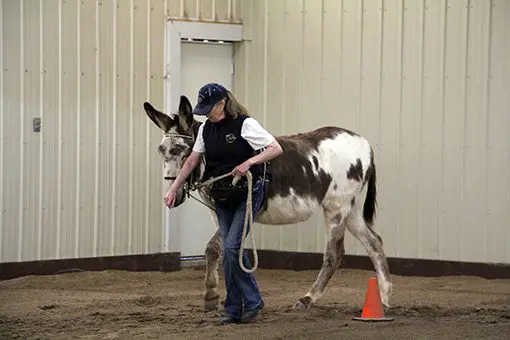

Chasity began by leaning on the “Elbow Pull” to keep her reasonable good equine posture. After a month of work, she is now able to sustain her own self-carriage a good part of the time. When she leans on the “Elbow Pull,” it is taut and when she is in self-carriage with good postural balance, it is loose. She started over the first pole and it was loose, then caught her balance on the second pole and it tightened…


On the third pole, she regained her balance and the “Elbow Pull” became loose again, but stepping over the last pole she allowed her balance to be too elongated and had to lean on it again.


As Chasity walked away, she again resumed her good equine balance and self-carriage and the “Elbow Pull” was loose again. We repeated the poles a little later in the Hourglass Pattern and she was then able to sustain her balance and self-carriage over the first pole…


…over the second and third poles, in good equine posture and not leaning on the “Elbow Pull”…


…and finished over the fourth pole with no loss of balance at all! As she is strengthened in good posture, her core muscles, ligaments and tendons will gain strength with symmetrical development and her time in self-carriage will increase. Ultimately, the “Elbow Pull” will remain loose at all times. She now walks in a rhythmic and cadenced fashion, matching every step that I take and halts easily upon request with no anxiety, or excess movement.


I asked her to square up and this time, instead of just flexing at the poll, I asked her to lower her head and stretch her entire spine from head to tail. Then we proceeded with more work in the Hourglass Pattern in the opposite direction and she practiced bending through her rib cage while staying erect around the corner cones.


Next, we negotiated the gate into the obstacles area, halted and squared up. I gave her a reward and asked her to stretch down again.


Chasity has been doing very well with breaking the bridge down into small steps. She halts easily, squares up and holds her balance in several new positions, with the front feet up, back feet down…


…with all four feet on the bridge and with front feet down and back feet up. She did very well at stretching her spine in all of these odd postions that added to her symmetrical core development.


Then she squared up again off the bridge and did one more deep stretch. Chasity was surprised to see the tarp where the tractor tire used to be and took exception to this “new” obstacle. The silly thing was that she side-passed the rail with her front feet on the tarp and her back feet in the sand. I thought, “Okay, now I know how to get her to side pass when I am ready! Silly Girl!” LOL!


We went back and tried again. She was hesitant, but realized what it was this time. I have to remember, Chasity has cataracts in both eyes and cannot see very well…trust is everything! There was no problem at all with the familiar smaller tires!


We reinforced her bending with the barrel exercises and practiced backing through the Back-Through “L.” She is still a bit “stuck” in reverse, but it will loosen up in time. She needs to learn to manipulate her body in a good postural balance and it is awkward for her now. It will just take patience and moving slowly. Speed will come with practice.


A nice deep spinal stretch relaxed and prepared her for the final obstacle! Chasity had been doing “Evasion Therapy” on me when I placed the tractor tire obstacle with too much open space around it. Boy, was she surprised to find out it was right there in front of her with no where to go but forward!


Chasity only put one foot inside the tire as she danced along the edge with her other three feet, so I opted to do it again the other way. This time, she put two feet into the center of the tractor tire… PROGRESS! Coming back through, she finally agreed to step through it with all four feet!


Finally, SUCCESS! My patience had paid off and our relationship was still intact! We finished with another REALLY DEEP stretch. Chasity’s flexibilty and elasticity were improving rapidly! Doing obstacles in confined spaces in the beginning promotes success and I am all about setting up your equine for SUCCESS!



CHASITY’S CHALLENGES: Chasity Finds Flexibility: 4-28-20
4-28-20
Chasity does not have the most optimum conformation anyway, but when she first arrived, she was really stuck in a bad posture. She moved with a hollow back and her legs did not reach underneath her body when she walked. Her body did not allow for a flexible spine with ideal movement through her joints and I would presume that internal organ function was also compromised. Her body was very stiff and flexion of any kind was difficult for her. The bacterial infection in her udder was old and persistent. With our feeding, management and exercise program, Chasity has improved substantially and now enjoys a much more posturally correct body, more flexibility and a bacterial infection that is receding rapidly with antibiotics and the right kind of exercise. She is now happy to come to the stall door to accept her halter and “gives” easily and willingly to have the “Elbow Pull” postural restraint adjusted!


Standing in a 4-square posture used to be really difficult for Chasity and with her rigid back, she was unable to stretch her spine and flex at the poll while standing with equal weight over all four feet. With a month of our postural therapy leading exercises through the “Hourglass Pattern” this has changed dramatically and she can now flex easily when prompted.


Bending through her rib cage around the turns, while remaining erect in her body, was also impossible at first. With each new lesson, she continues to improve in both directions. The neck sweat encourages shrinking of the fat deposits on her crest and the bending is improving the alignment in her neck.


Work over the ground rails at the center of the “Hourglass Pattern” is helping her hoof-eye coordination, enabling proper foot placement, suspension and self-carriage in her body.


Chasity enjoys the simple challenges of these exercises as they provide more comfort in her body than she has ever known! She is happy and enthusiastic about these sessions!


With the rapid improvement through her body during the flatwork exercises in the “Hourglass Pattern,” we were able to begin going through some very simple obstacle exercises that made the sessions more interesting for her and kept her alert while adding some coordination to her body. The repetition of going through the gates the same way every time taught Chasity to wait patiently, bend correctly through her rib cage when walking through them and to consistently stand 4-square on both sides.


Breaking the obstacles down into smaller steps taught her to be alert and attentive to my commands and allowed her to learn to rebalance properly in each of these new positions.


When I first began the obstacles, I did not ask her to do the most difficult position of standing with her front feet down and her back feet on the bridge. She has been very good about stopping when I ask, so I decided to try it today and she did GREAT! I did not ask her to square up in this position yet, but I will as she becomes stronger in her core and can hold the position more easily. Then we walked of the end of the bridge and squared up again.


The first attempt at the tractor tire, Chasity walked up to it and looked at it, but would not do any more than that. The last attempt at the tractor tire, Chasity allowed me to pick up her foot and just direct it toward the middle like in the first photo, so I left it at that, rewarded her and asked no more. Today, she went one step further and offered to extend her foot herself, but still would not place it in the middle of the tractor tire, so we stopped, rewarded and will continue again next time! She is getting a LITTLE further each time and that is “rewardable” in my book! To force it would only result in a fight and probably wouldn’t get the job finished anyway! I am sure we will have better luck next time!


The last time over the smaller tires, she was hesitant. This time she forged ahead like a pro! And, going forward through the barrels was no problem at all! We might try backing through them the next time if she is willing.


Backing through the Back-Through “L” is getting much better and the tarp is a cinch! This time, she went right down the middle with no trouble at all! Taking small steps is critical to success!


Chasity has become a pro at negotiating the gate, standing perfectly and waiting patiently on each side.


The broom is yet another obstacle and Chasity learned it would not bite her as I politely swept up around her. She was rewarded for staying calm and afterwards, we did some spinal stretches.


Then it was time for yet another soak of her infected udder. The vet arrived to do a check and was so happy to find that we had reduced the infection by 70% in only 14 days! He really did not expect that! He also commented about how much better her posture was and the strength she showed over her top line. We opted to do a second 14-day run of the same antibiotics and continue the exercise and soaking.


Chasity no longer needs to be led into her stall and turned around to take off the halter. She can now be sent in and turns to face me of her own free will! Core strength postural exercises have a profound effect on the equine’s body and mind! Chasity is yet another example of the dramatic results that you can see when employing this relatively simply feeding, management and training program. It is not only for rehabilitation, but rather, it is a program that can give your equine athlete optimum health and the opportunity to perform to the best of his ability! Just ask Chasity!


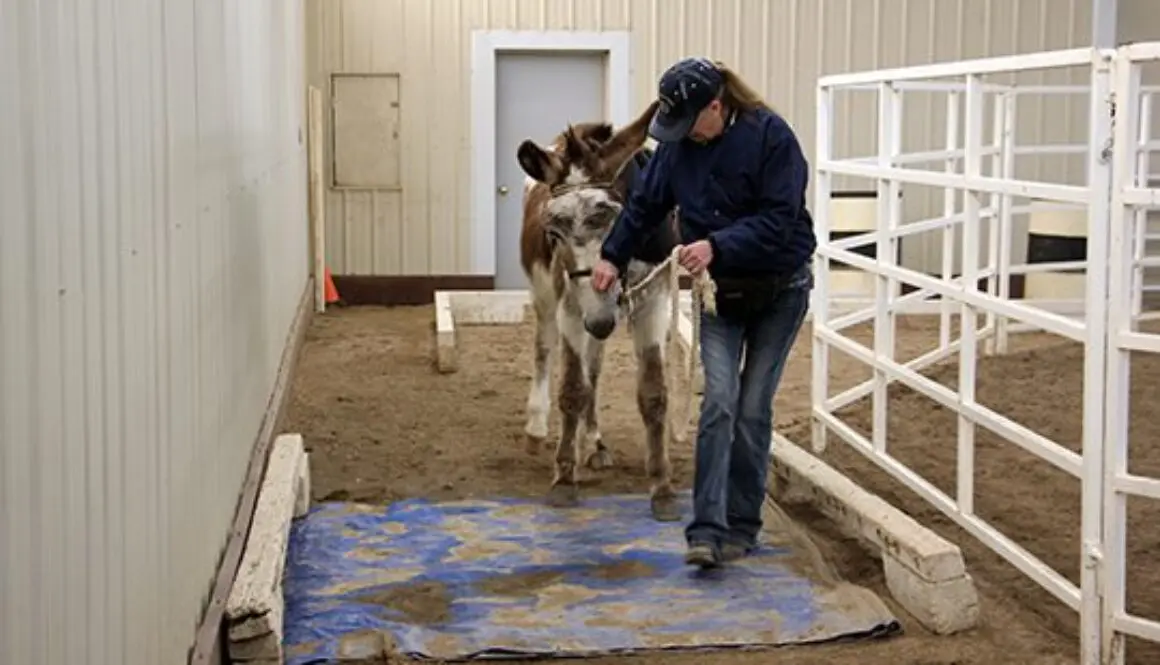
CHASITY’S CHALLENGES: Obstacles for Coordination: 4-14-20
4-14-20
After doing her Hourglass Pattern exercises, first one way and then the other, we opted to add some variety to the workout by adding some straight forward obstacles. In our indoor arena, I have an open space of 60’ X 120’ and a 45’ round pen at the end of the arena in another 60’ X 60’ fenced off space. Around the outside perimeter of the round pen in that area, I put my obstacles. I have found that there is less margin of error learning obstacles in a confined space to add coordination to their core strength in good equine posture. They can learn to pay more attention and to be more meticulous in their execution of the obstacles. This is a helpful way to begin with obstacles. The first obstacle for Chasity was the gate!


After going through the gate and standing stock still while I latched it, we proceeded to the bridge. I was pleasantly surprised when she allowed me to stop her with only her front feet on the bridge. This is generally a Stage Two move in my program since obstacles are used for coordination. Most equines are so uncoordinated that they just want to keep walking over and through the obstacles without stopping at first. Good for Chasity!


Chasity then carefully walked up onto the bridge with all four feet and halted on command! This was going much better than I had expected!


When I asked her to square up, she got a bit skewed to the side on the bridge, but she was nevertheless squared up, just not in line with the bridge. So I took it and rewarded her effort.We can do better the next time.


Then we got off the bridge and I squared her up again. Then…I introduced her to the tractor tire.


She looked at it…wasn’t afraid of it…walked around it…


…and looked at it again. She was clearly NOT going to put her foot in the middle of that tire! I decided to quit while we were ahead and try again next time. Because I didn’t push her, she consented to walking through the smaller tires…


…tentatively, but she did it! And then she walked around the barrels with no trouble at all!


Just having Chasity navigate these obstacles without being afraid of them was a major accomplishment. We then walked into the back-through “L” and I decided to make it a little bit tougher.


After walking through the “L” forward, I asked Chasity to back through where she had come.


She was a bit perplexed, but slowly backed between the rails, made the turn at the elbow, and went straight back from there with very little forcible encouragement.


Once at the end of the back-through “L,” we headed for the tarp. She followed me obediently, but was so silly…


When we got to the tarp, she wanted to walk EXACTLY where I walked! I guess she KNEW it was safe there! Too funny!


I gave her a reward because she really didn’t balk and we proceeded out of the obstacle area.


As we left, we executed the gate correctly and she was rewarded again. She stood quietly until I was ready to move.


Then we proceeded down the arena wall towards the exit gate and stopped to turn off the lights. She was a little surprised that the wall opened up, but stood still while I opened the door and turned off the lights.


Then I closed the door and we exited the arena. Adding obstacles and simple expectations to her regular work in the Hourglass Pattern made the experience more interesting and engaging to Chasity. When you add new things to their lessons, you shouldn’t feel like the equine has to do it right the first time. Just quit while you are ahead and your equine WILL do better the next time! There is no battle to remember!


Beginning by negotiating obstacles in larger areas makes for a larger margin for error. Too many things can go wrong and lead to an unpleasant chain of negative events that suck you and your equine into unnecessary altercations. There is plenty of time to do them in the more open spaces once they have learned how to negotiate them in the smaller spaces. I first school green animals during ground driving and under saddle in the small open area of my indoor arena (60’ X 120” – Standard Small Dressage Arena Size) before I take them into the larger outside arenas. This has resulted in a decrease of bolting and running. When you set up your training environment, it is always optimal to set up the equine for success!


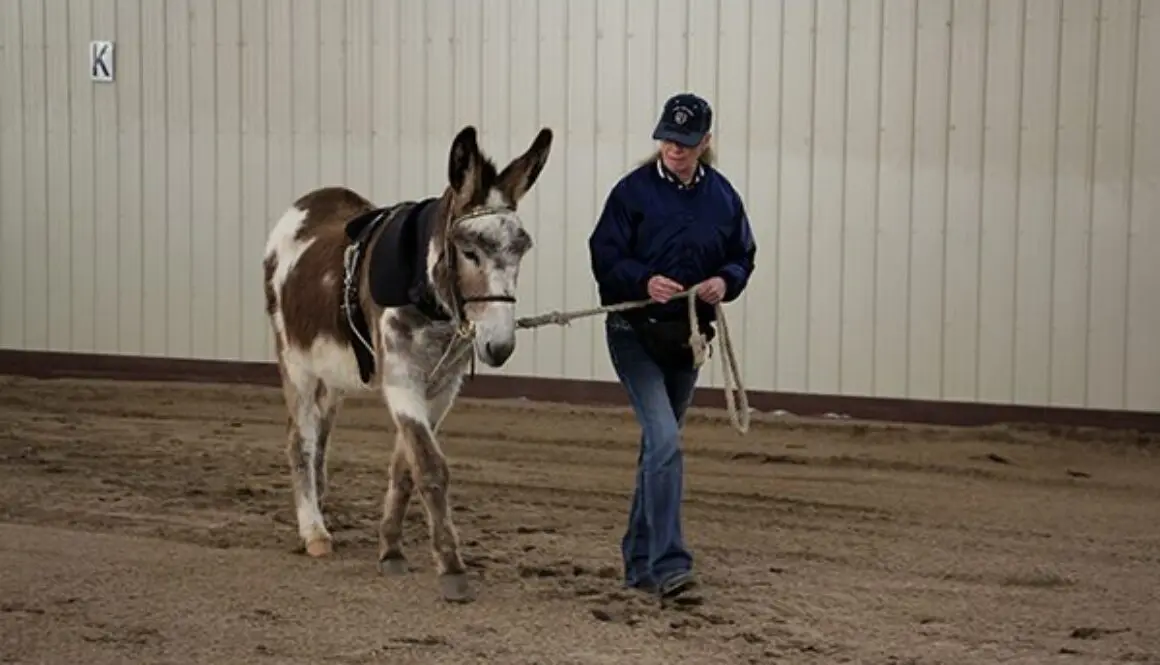
CHASITY’S CHALLENGES: The Hourglass Pattern for Good Posture: 4-14-20
4-14-20
The “Hourglass Pattern” is an amazing therapeutic approach to conditioning that I have used with all of my equines of varying ages, sizes and breeds. It builds a foundation of symmetrical strengthening at the core involving the ligaments, tendons muscles and soft tissue that support the skeletal frame and promotes even wear of the cartilage between bones in the joints. It can prevent arthritis as the animals age. This is vital to your equine athlete’s health. Chasity and I open the gate to her rebalancing and rehabilitation exercises in the “Hourglass Pattern.”
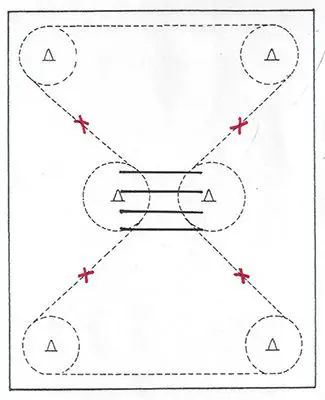

The red “X’s” in the pattern represent the points where you are to halt, square up, reward and wait. This process becomes helpful as your equine learns to navigate gates properly and learns to wait patiently through repetition and consistency in your behavior. Always go through gates exactly the same way so your equine knows what to expect. Abrupt actions lead to chaos.


We want to promote self-carriage, so we do not hold the lead rope in the right hand when leading from the left side where it can subtlety cause movement in the head and neck from side to side, adversely affecting their balance. Rather, we hold the lead rope in the left hand when leading from the left side and in the right hand when leading from the right side. We lead from the inside of the arcs in direction through the pattern. Always, say the animal’s name, give the command to “Walk On,” look where you are going, point in the direction of travel with your other hand and walk in sync with the equine’s front legs. This facilitates good posture for both of you!


When negotiating the “Hourglass Pattern,” there is an internal pendulum that swings back and forth and comes to center each time the animal halts and is squared up. If you were to work only along straight lines there is an optical illusion that takes place along the perimeter and makes the animal’s body lean to the inside of the track, and when halted, they cannot find the center of balance. Every time you halt, square up your equine and reward with the crimped oats that you keep in your fanny pack around your waist (other “treats” will not work the same way!). Then wait until they finish chewing so they can settle into their perfect balance unobstructed.
As they progess, they learn to bend to the arc of the turns through their rib cage, carry their body erect in good posture supported by stronger ab muscles that round the back upward as they learn to give to the “Elbow Pull” such that it remains loose. When it is tight, they are simply having difficulty holding their good posture and lean on the “Elbow Pull” much like a beginning ballet dancer must use the bar on the wall. Many people think that you do your equine a favor by not putting a bit in their mouth, but you cannot affect their posture without one. The animals that are not bitted and schooled in good posture can have all kinds of postural issues as they age. Chasity is falling in and out of good posture because she is only in Week Three of her training. As she improves, she will be able to keep the “Elbow Pull” loose for longer periods of time until it is always loose.


As this way of moving and standing becomes more habitual, so does their comfort in these positions. When they rest, they will stand 4-square instead of with splayed legs, or a hip dropped and a foot cocked. They are happy and deliberate in their movements and good posture continues to improve until this become their new habitual way of moving and resting. You will see marked changes in their play and rest patterns while in turnout.


Adding rails to the center of the pattern keeps them attentive, alert and teaches exact hoof placement (hoof-eye coordination). As their movement becomes more deliberate and balanced, their confidence is increased as is their trust in you for making them feel so comfortable in their own skin. They learn to wait for your command before moving. They look forward to their time with you and will gladly leave the herd to be with you! No more herdbound behaviors!


We build this foundation through the “Hourglass Pattern” first during leading training, then after obstacles and lunging training during Ground Driving, and finally Under Saddle. Each stage produces new challenges to the equine’s body and mind that add to their overall development in a logical, sequential and healthy way. Because of all these small steps, with gradual difficulty, it is easy and fun for both you and your equine to do. You are never over-faced with difficulty and you learn to appreciate the little victories along the way! Chasity was somewhat of a pushy, bully to start with, but she now waits patiently when I ask and navigates movement in much better posture, even after only three short weeks! More dramatic changes to Chasity’s body and mind are still to come! It’s not just about the end result. It’s all about the journey!


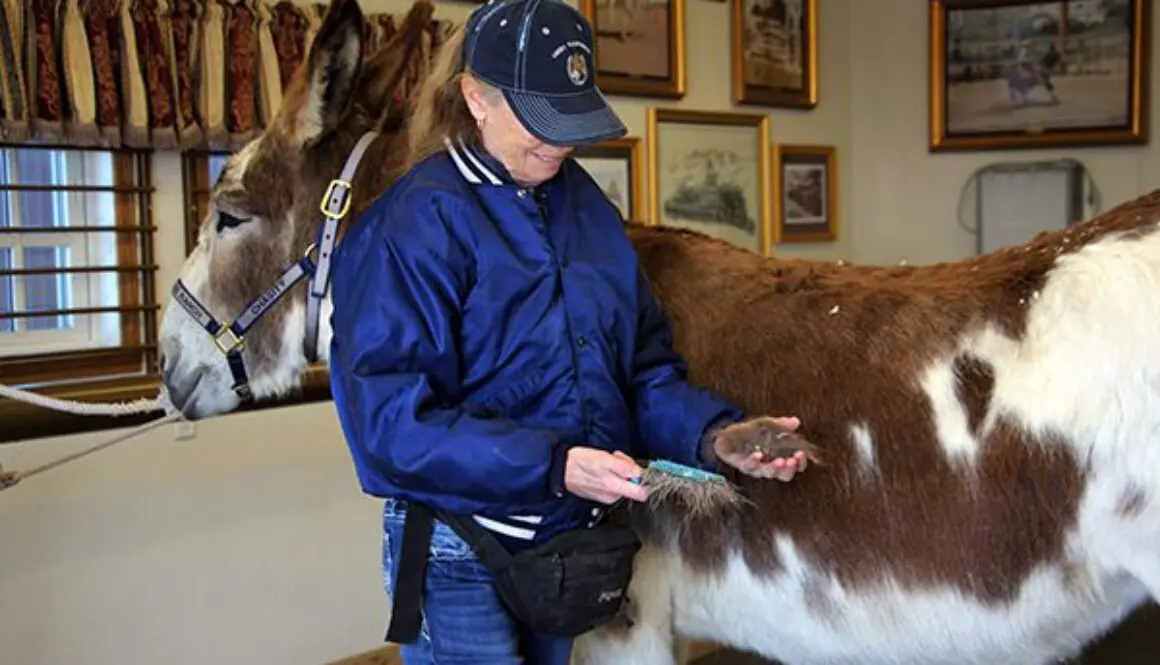
CHASITY’S CHALLENGES: Grooming Routine: 4-14-20
4-14-20
Grooming is an important activity in your equine’s life and it need not be a struggle if it is done regularly. Chasity was not real sure of us, or what to expect when she first arrived, but she is gaining confidence and calmness with each grooming session that precedes her workouts. Right off, she is rewarded for going to her designated work station. This familiarity sets the stage for the tasks to come.
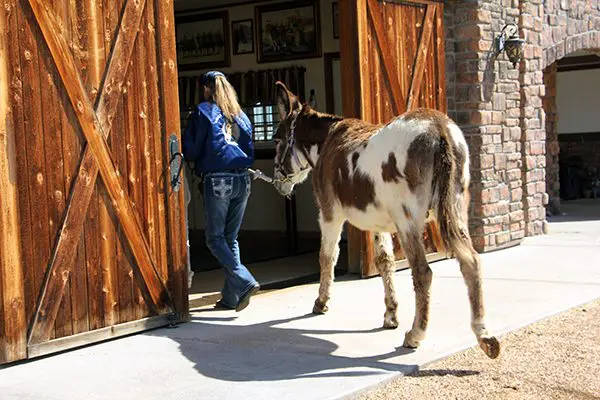
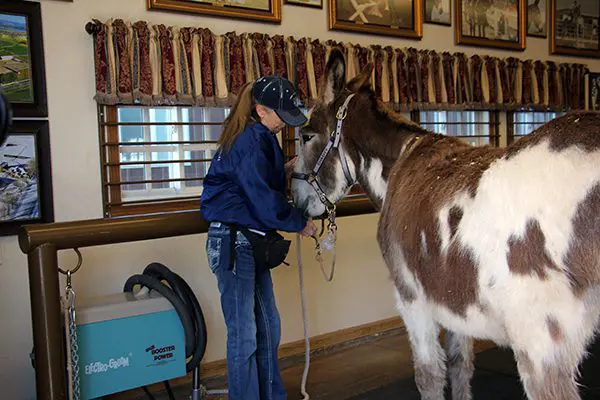
I begin with a wet towel to clean her eyes, then her nose and finally her ears. When cleaning the ears, I stroke upwards with the hair and try not to go against the way it grows. Most Longears enjoy having their ears rubbed anyway, but HOW you do it can make a huge difference in their willingness to comply.
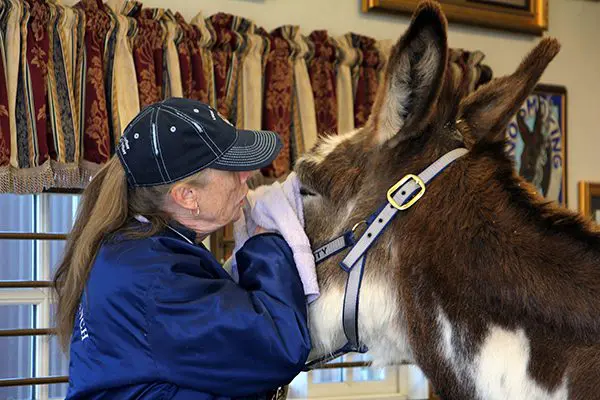
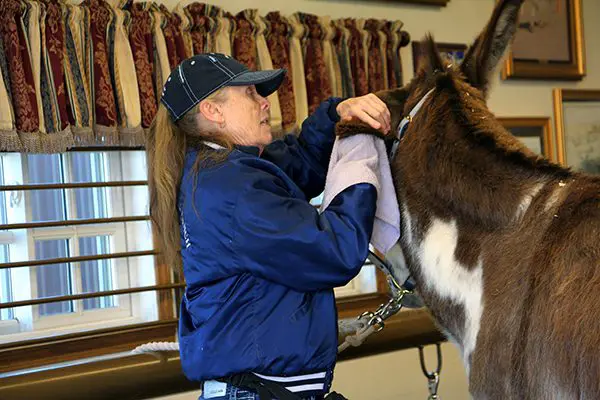
Then I begin on her forehead and along her neck with a human, multi-bristled plastic hairbrush. If she had mud on her, I would have scraped that off with the shedding blade first. The human hairbrush is much more effective in getting deep into thick donkey and mule hair and will “aerate” the coat nicely where the shedding blade will only skim the top and often break the hair.
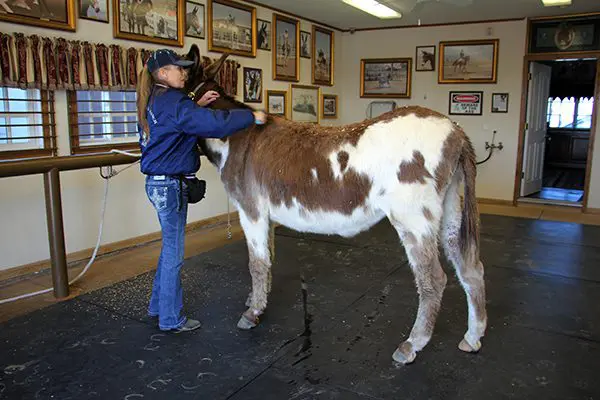
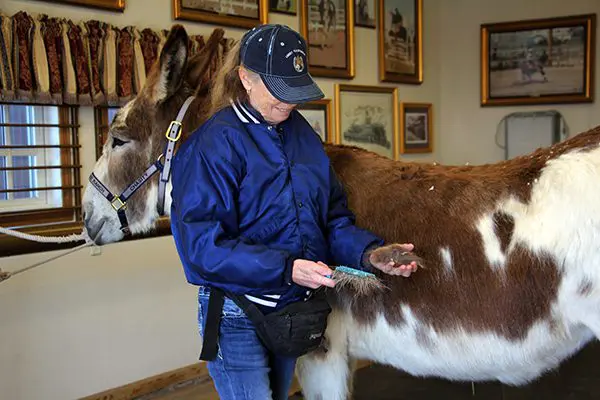
Chasity’s teats were as hard as a rock, but were draining a milky-looking substance. At first we thought she had just weaned a foal, but we found out later, that was not the case. At any rate, during grooming, I scraped the sticky drainage from her back legs. Then I discovered some crusty spots across her chest that resembled an old bot-hatching site that had not been addressed.
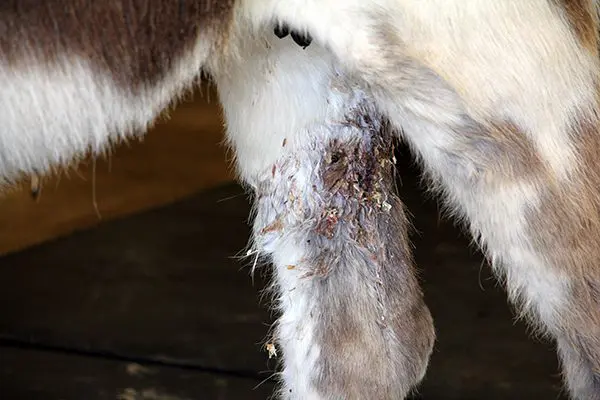
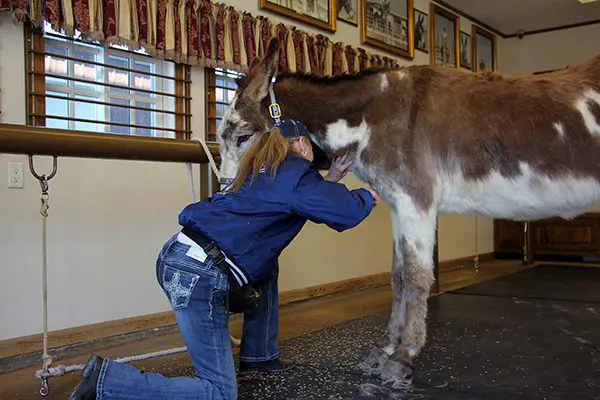
I used the shedding blade to scrape off the scabs and applied Neosporin to the area. Over several days now, the scabs are beginning to go away. Chasity enjoyed the scratching! They must have been itchy!
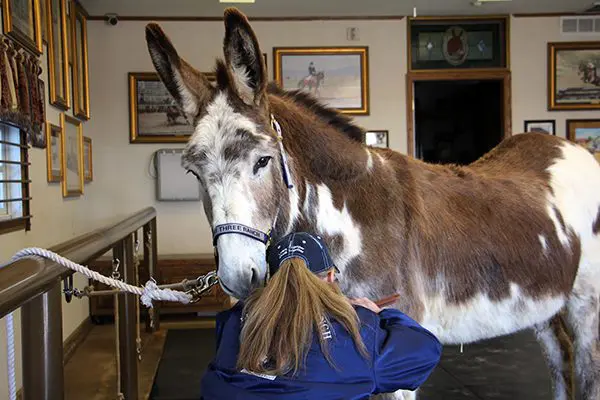
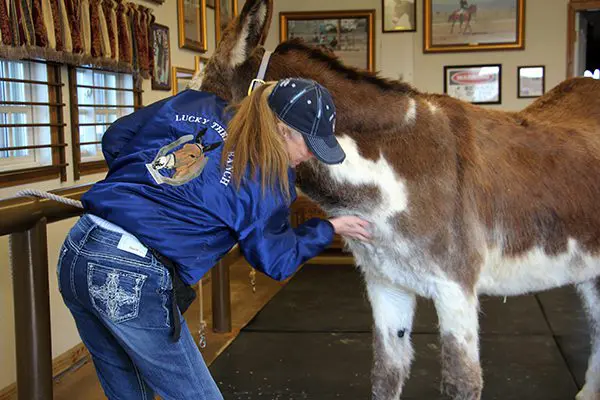
Chasity has an enlarged, crested neck and fatty deposits over her body that will need some attention. The crest has fallen over quite a bit, but I do think it is salvagable. It will just take the right kind of feed and exercise, and some time to correct.

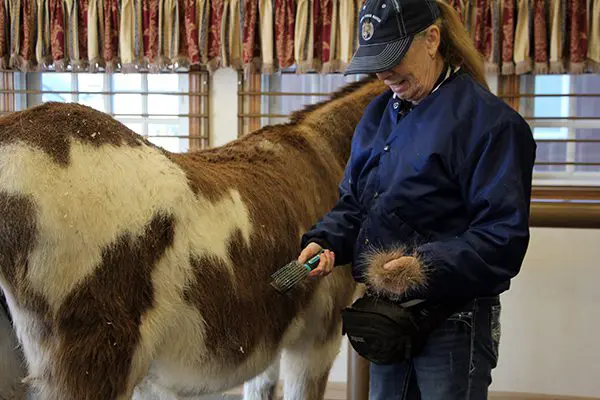
On her withers, Chasity has some scarring where the saddles previously used on her were rubbing and turned the hair white. She is also sporting a bit of Lordosis (sway-backed) which should not be seen in an animal of her young age of 13 years. This will undoubtedly result in irregular movement when seeing how out of alignment her spine is with these issues. Equines are not designed to carry weight on top. Rather, their structure supports carrying their weight below the spine. This is why is is so important to pay attention to core exercises to strengthen the top line and abs to prepare to support the rider’s weight. Just because they are big animals doesn’t mean they can automatically carry our weight without undue stress on their bodies.
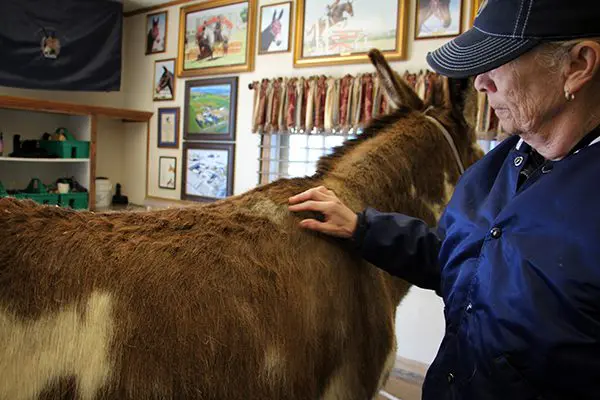
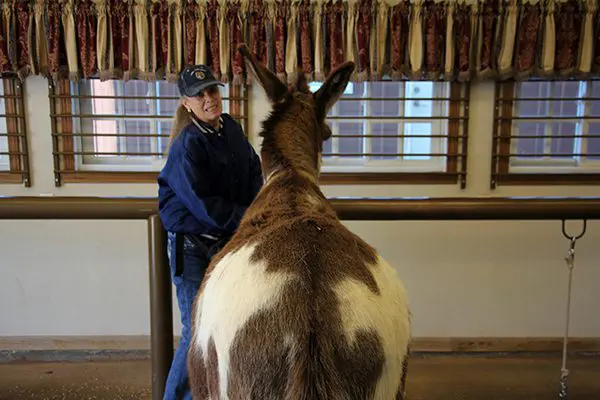
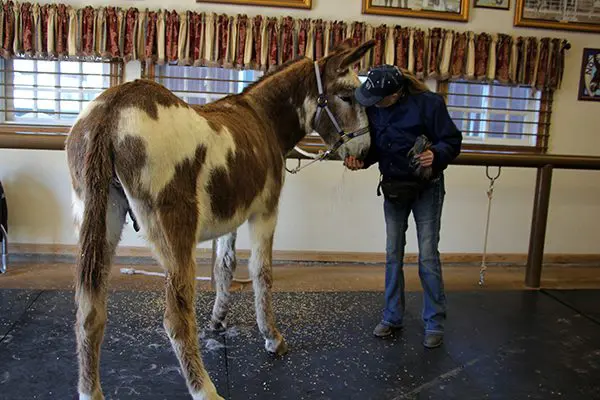
The crusty discharge on her legs is very sticky, so I sharpen my shedding blade before going after it. It is going to pull the hairs hard enough as it is. I want the shedding blade sharp so it will come off quickly and with as little pain as possible. Chasity appreciates my consideration for her!
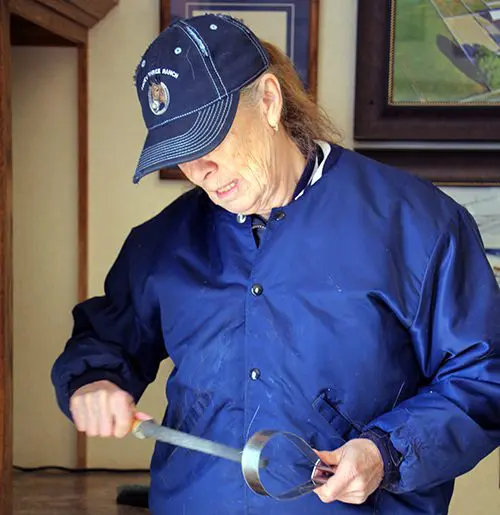
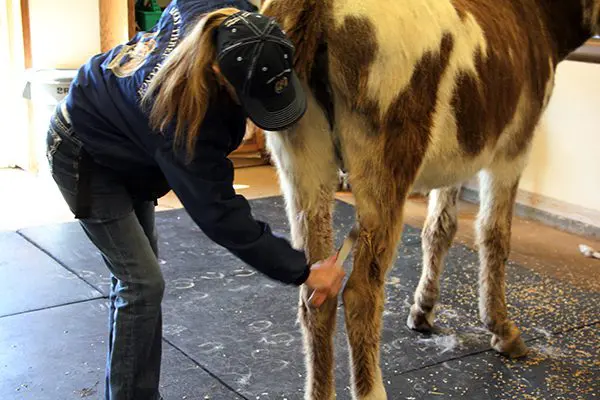
Last, but certainly not least, I sprinkle Johnson’s Baby oil in her mane and tail. This protects the hair from drying out during inclement weather, will promote growth and keep other animals from chewing on it. Then I square Chasity up one more time in preparation for either tacking up or for leaving the work station. Although this all seems simple enough, keeping this routine weekly will keep things from getting out of hand and grooming will remain easy each time. A reward of crimped oats from the fanny pack around my waist is always in order for standing quietly in good posture!
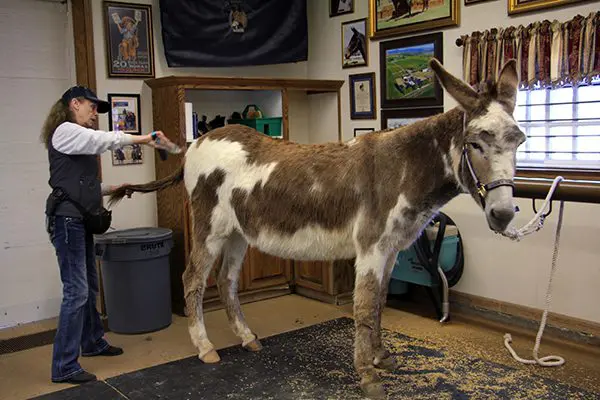

If you have multiple animals, just take your grooming tools in a bucket and your fanny pack full of oats with you to their stalls and do them there. If they are all in one pen in a herd situation, do not wear your fanny pack until they can all be rewarded at the same time, at the end of grooming. Body clipping is not a healthy solution and should only be done when showing. During shedding season, it is impossible to get it all done at once and still keep the hair coat healthy. It is easier if you do it weekly and take off the excess hair gradually. When grooming is done regularly and goes easily, it greatly reduces anxiety and bad behaviors.
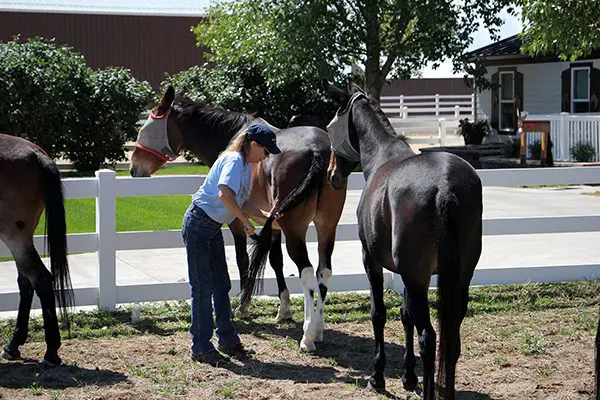

CHASITY’S CHALLENGES: Learning to Come to Be Haltered: 4-14-20
4-14-20
We determined that Chasity had cataracts in both eyes, worse in the right eye than in the left. This made her hesitant to come to me at the stall door to be haltered. She wanted to come to me, but she just wasn’t sure. I insist that ALL my equines come to the stall door or gate to be haltered, so I knew I would have to train her and win her trust to get her to do it like all the others.
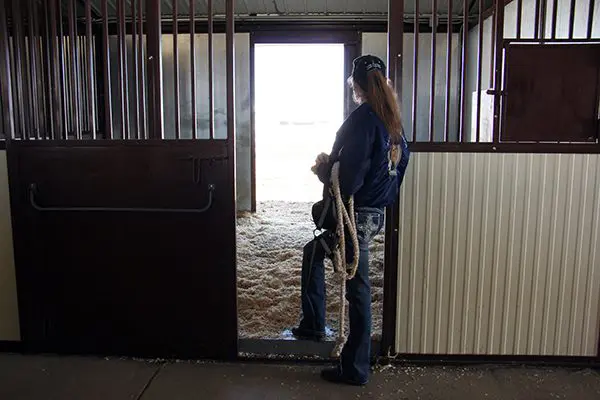

When she went away from the door, I simply stepped to the inside door of her stall and encougraged her to come to me from there, but she was still suspicious and ran to the far side of the pen. I just walked toward her and spoke in a calming fashion telling her to “Whoa.”


She began to get nervous and started to weave away from my approach, but before she could suck me into the back and forth along the fence, I stepped to the side, waved her into the stall and shut the door behind her.


She knew she was confined and went to the corner of the stall. I knew she could not see me very well with her right eye, so I opted to walk along the wall to her left side and approached her from the left side. Before attempting to put on her halter, I told her what a good girl she was and offered a handful of oats. I allowed her to finish chewing them before I put on the halter.


I was careful about putting on the halter slowly so I would not startle her and then gave her a reward of more oats for standing still. She was grateful and again, I waited until she was finished chewing before asking anything more from her.


Then I asked her to square up with equal weight over all four feet. This would become the protocol EVERY time she stops. I want to change her posture and begin to increase her core strength in good postural balance. The repetition of this movement will change her habitual way of standing.


I rewarded her again and then took off the halter while standing by the open door and watched her chew.


I rewarded her for NOT forging through the door, waited for her to finish chewing and then put the halter back on.


We then turned around and walked to the back of the stall to open the door I had closed, did another turn and exited the stall. She will soon tire of me going into the pen and chasing her into the stall. One thing that is also VERY important in halter training is the type of halter that you use. Although they do provide leverage, rope halters have pressure points everywhere there is a knot and the biggest knot is right underneath their ear. Try putting your index finger underneath your ear and ask yourself how long you could stand it just being there? Now put the palm of your hand under your ear. How does that feel? Nylon webbed halters lay flat against their face and do not cause distractions like rope halters will. The equine can focus their attention 100% on YOU and not be distracted by subtle pressure points!


I would much rather encourage my animals to comply happily and willingly than try to use any kind of forcible leverage with them. I have found it to be unnecessary. Building a willing bond between you prevents them from becoming herdbound and being sour about leaving their friends. It enhances the relationship between you so they really WANT to go with you. This particular routine gave Chasity an idea of what to expect and resulted in her coming to the stall door willingly when I call her after only two times of having to proceed this way…completely resistance free. She is a very intelligent girl and learns quickly despite the disadvantage of cataracts. I have other equines with eyesight issues that have been successfully trained the same way. The key is patience, understanding and a careful, respectful and sensible approach.


CHASITY’S CHALLENGES: Removing Chasity’s Shoes 4-2-20
4-2-20: Our farrier, Dean Geesen came out to take care of Chasity’s feet. The first order of business was to introduce himself with an offer of oats! She did not want my veterinarian, Greg Farrand, to pick up her feet on Tuesday, but during grooming on Wednesday, Ranch Manager, Chad and I cleaned her feet, so she was much more compliant today. Getting her hooves in balance will greatly improve her overall body balance. And, getting the shoes off her overgrown front feet will enable the frog to do its circulation job!


Her front hooves were exceptionally long with Borium shoes (non-slip) on them and her back feet were long and uneven. All four feet had been trimmed out of balance.


Dean showed us how the shoes had been abnormally and unevenly worn.


Dean removed the shoes and trimmed her hooves in the best balance that he could for now. Her hooves had been pressured to one side and would need several trims to get them properly symmetrical in alignment.

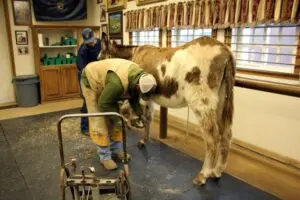
Dean is a correctional farrier and knew just what to do to get her started off on the right ‘foot’ so to speak. It was a definite improvement from where she was!


She will need to be checked periodically to keep her feet in good shape as she moves forward in her therapy. Sometimes these kinds of things just take time!


She was rewarded with oats in appreciation for her cooperation! Chasity seemed thankful for her newly balanced hooves.


CHASITY’S CHALLENGES: Maintaining a Happy Donkey: 3-2-20
When Chasity first arrived, we needed to keep her in quarantine, away from the other animals for a minimum of two weeks. Over the past 41 years, we altered our facility to an all-steel facility. Reduced maintenance costs enabled us to proceed converting from wood and wire to steel until we completed the process. This has greatly reduced the overall maintenance costs for the entire ranch, enabling us to purchase steel panels for the barn runs. It was easy to quarantine Chasity safely and still allow her company (at a distance, of course!) and an introduction to her future stable mate, Wrangler. About every five years, we do have to spray paint the panels to keep them looking new, but this is a small price to pay for a happy donkey!
Once out of quarantine, Chasity and Wrangler were stabled next to each other. All of our runs are bedded with four inches of pea gravel. This promotes good drainage and keeps things from getting muddy. This, in turn, provides a hard surface for good hoof health and will not chip their feet because of its rounded shape. Each of our donkeys is given a soccer ball for play in the smaller areas. The ground surface is also soft and comfortable enough for them to lie down without causing shoe boils or sores. They learn to come by calling them to the end of the runs and rewarding with oats.
The mini donkeys’ pens are the same way, as is the road around the sandy dressage arena where they can also be turned out in the larger dirt area when it is not in use. They really enjoy a good roll in the sand.
Donkeys are desert animals and can easily become obese when exposed to green pastures. I only take my donkeys out to pasture to play with me.
My 60’ x 180’ indoor arena is lined with steel panels. I have a 45’ Round Pen at one end with obstacles inside the side gates around the south end. The enclosed area makes for good obstacle training with minimal distractions. Round Pen work and turnout in the open area during bad weather is completely safe and NON-DESTRUCTIVE!
At first, Chasity would not come to me at the stall door, but after being chased once into the stall to be haltered, she soon gave in easily. I always halter in exactly the same way, in the same place. They love routine.
The oats reward assures that she will repeat the behavior. After only one lesson, she now comes to me every time to be haltered. For clean, dry stalls, we bore a 2’ wide x 4’ deep hole in the center, fill it with 1 ½” rock, cover it with four inches of pea gravel and put rubber mats on top. The pea gravel is held in with 2” x 6” boards bordered by angle iron.
Since we had no animals in the north stalls, we took down the panels and made a large turnout area bedded in four inches of pea gravel for Wrangler and Chasity. It was plenty large enough to romp and play…and not get muddy!
When I am out and about the barn, I reinforce Wrangler and Chasity’s will, as well as all the others, to come to me for their oats reward. We keep bulk rock, pea gravel and structural fill in bays behind the indoor arena.
When the equines are in turnout, we replenish the pea gravel as needed with the Skidsteer.
Wrangler and Chasity, our miniature donkeys Augie & Spuds, miniature mule Francis and miniature horse Mirage also have alternate access to a very large 2 ½ acre dirt pen…Large Standard donkeys one day, miniatures the next.
When it is dry, they can take turns on alternate days in the larger area to stretch their legs and buck to their hearts desire. They do not seem to miss being in the pasture with this kind of management and they really do stay very healthy. We have no incidence of colic, founder, abscesses, skin irritations, rashes or obesity.
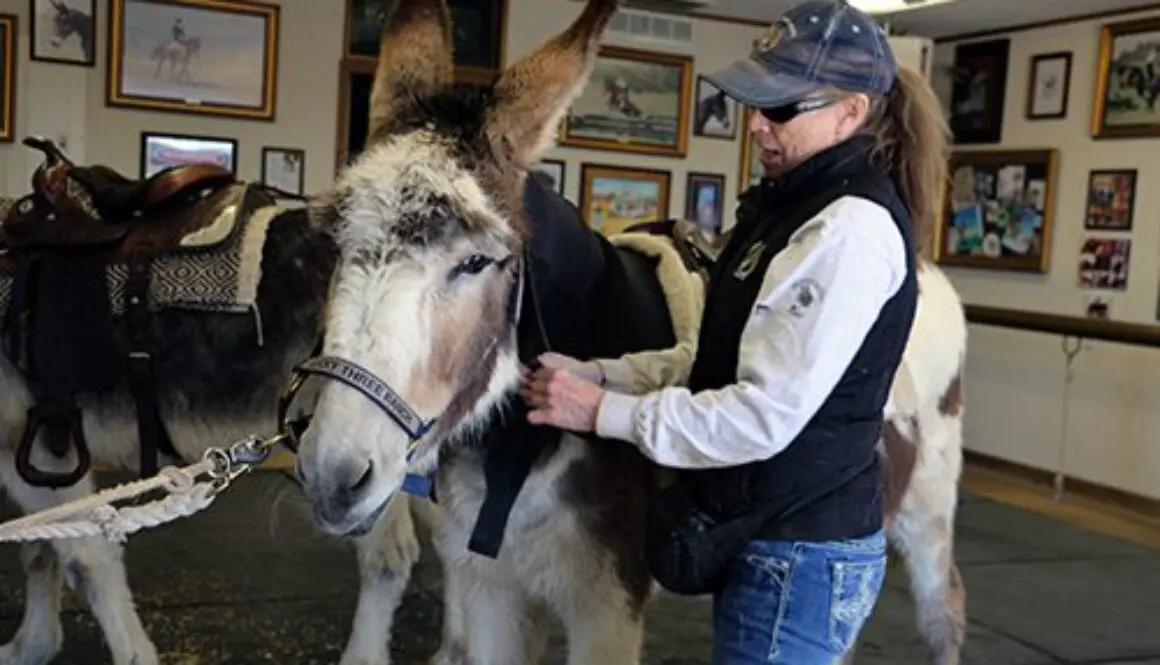
CHASITY’S CHALLENGES: After the Winter Break: 3-29-21
Due to the colder and more inclement weather here in Colorado, Chasity has been off her exercise program for about three months. It was time to get back to work! No matter how long it has been between lessons, when you have a specific routine, the equines seem to comply easily because they know what to expect, beginning with going to their regular work station to be groomed and tacked up. In order to keep upper respiratory disease at bay, eye infections and ear problems to a minimum, it is advisable to clean these areas with a damp towel regularly. Be polite and wipe the towel in the direction that the hair lays and clean the nostrils with a circular motion. This repetition will prevent them from getting head shy.
Chasity still thinks the vacuum cleaner is questionable, but she tolerates it now. Not only does it pull the dirt from the skin for healthy hair growth, it also promotes circulation better than massage and does a better job at softening her “fat roll.” I used massage in the beginning when Chasity first came here with her enlarged crest (photo below on the right).
It had become somewhat enlarged again about three weeks ago, but after two sessions with the vacuum cleaner, it has decreased substantially already.
Another valuable therapeutic grooming tool is this simple human, multi-bristled hairbrush. It is not only VERY helpful during shedding, but also works to further stimulate the hair coat and promote better circulation, as well as efficiently removing dirt from the skin. I have found it to be more helpful for healthy hair than any equine grooming tools. The long, thick hair coats of winter and spring stay soft and healthy when I use this hair brush over the entire body. I only clip bridle paths when the weather gets warmer and I leave body clipping for showing. The only other grooming tools I use are a shedding blade to remove mud and a dandy brush to finish the coat. They can have balding spots from rubbing during the shedding season and may even get sores, but I just treat those with Neosporin and they recede quickly. A healthy hair coat will insulate your equine from the heat and cold and protect them from insects better than any artificial products or practices.
Equines do like feeling clean all over and really do appreciate your efforts at keeping them this way…although, they don’t necessarily show it when the first thing they do after a good grooming is to go for a good roll in the dirt!!! Still, they do seem to realize that you care and will show their appreciation in a multitude of other ways…like being happy to leave their companions to go with YOU and stand quietly during grooming, tacking and hoof care!
Feeding is a very important consideration for healthy hooves as are regular trims when needed, usually every 8-10 weeks. For donkeys, it can even be longer between trims when they wear their hooves in good balance. Chasity had hoof issues when she first arrived, but is now sporting healthy balanced feet! Remember that Longears will be more upright and have more heel than horses and ponies…and donkeys will typically be more upright and have more heel than mules.
Fitting saddles can be tricky. Make sure the saddle makes even contact behind the withers and over the back with relief from pressure over the spine. Many saddles sit too high and cause centralized and uneven pressure across the back. Pressure points are easily identified after a workout. The back will be sweaty, but the pressure points will be dry.
Place the saddle in the center of the back, behind the shoulder blade, the girth falling 4” behind the forearm where the skin is thicker and body begins to swell. I have successfully used cruppers with the buckles set away from the tail to hold it in place. The crupper is adjusted with just enough tension so the tail will still be able to rest comfortably.
I am using the neck sweat on Chasity for lunging to promote a decrease in the crest. When bridling, I press my thumb on the bars of her mouth to get it open and protect her ears with my hands as I pull the crown piece to the poll. This promotes trust and keeps any equine from getting ear shy.
On an English saddle there is a small d-ring that I use to tie up the reins.
Then it is off to the Round Pen. I always stay in sync with their front legs when we walk and execute the gates EXACTLY the same way EVERY TIME! All movements are predictable, never abrupt. They comply due to trust.
I adjust Chasity’s postural restraint, the “Elbow Pull,” and then remind her to give to the tension to get the release with a reward of oats for flexing at the poll. Wrangler, “Mr. Curiosity” watches intently…they do learn from each other!
Chasity’s overall posture has changed dramatically as has her movement. She uses her body much more efficiently.
Chasity has strong hind quarter engagement with an uphill balance to promote enthusiasm, endurance and stamina.
A reward is always in order for a job well done. Her forward stretch has improved greatly in one short year.
The lateral stretches are also much improved. After five rotations of walk, then trot, then reverse and repeat the other direction, 3 sets with a 3 minute break in between, then stop. Done once a week is adequate to maintain conditioning.
I hold the halter crown strap in my hand and protect her ears as I remove Chasity’s bridle. Then I slip the bridle onto my left arm, bring the noseband over her nose with my left hand and fasten the halter to the strap in my right hand. This ensures that I can keep hold of her should she try to pull away. Last, I fasten the tie strap from the hitch rail.
I always unfasten the girth on the left, then tie up the girth on the right, slide the saddle back, loosen the crupper from the tail and take off the saddle on the right side. This gets the equine used to being handled from BOTH sides. I always rinse the bits and wipe any dirt from the bridles and saddles before putting them away…saves work in the long run!
I remove Chasity’s neck sweat to see how much sweat is underneath…encouraging! We are definitely making progress!
To end, we do a few more stretches in each direction. These are improving immensely, too!
Then it’s walking IN SYNC back to the barn for turnout in the larger dry lot. They enter the stall, ladies first, and then they both turn around to allow me to remove their halters and to enjoy their last reward. I keep all my donkeys off grass most of the time. I find that they stay healthier and do not run the risk of getting obese that way. They do have large dry lots for turnout on pea gravel every day and a couple of acres of dirt pen for really stretching their legs every other day. They do get some grass when we go for walks, but do not seem to miss it most of the time. They are too busy playing and resting with each other…and looking forward to our next lesson TOGETHER!

CHASITY’S CHALLENGES: Maintaining a Happy Donkey: 3-2-21
When Chasity first arrived, we needed to keep her in quarantine, away from the other animals for a minimum of two weeks. Over the past 41 years, we altered our facility to an all-steel facility. Reduced maintenance costs enabled us to proceed converting from wood and wire to steel until we completed the process. This has greatly reduced the overall maintenance costs for the entire ranch, enabling us to purchase steel panels for the barn runs. It was easy to quarantine Chasity safely and still allow her company (at a distance, of course!) and an introduction to her future stable mate, Wrangler. About every five years, we do have to spray paint the panels to keep them looking new, but this is a small price to pay for a happy donkey!
Once out of quarantine, Chasity and Wrangler were stabled next to each other. All of our runs are bedded with four inches of pea gravel. This promotes good drainage and keeps things from getting muddy. This, in turn, provides a hard surface for good hoof health and will not chip their feet because of its rounded shape. Each of our donkeys is given a soccer ball for play in the smaller areas. The ground surface is also soft and comfortable enough for them to lie down without causing shoe boils or sores. They learn to come by calling them to the end of the runs and rewarding with oats.
The mini donkeys’ pens are the same way, as is the road around the sandy dressage arena where they can also be turned out in the larger dirt area when it is not in use. They really enjoy a good roll in the sand.
Donkeys are desert animals and can easily become obese when exposed to green pastures. I only take my donkeys out to pasture to play with me.
My 60’ x 180’ indoor arena is lined with steel panels. I have a 45’ Round Pen at one end with obstacles inside the side gates around the south end. The enclosed area makes for good obstacle training with minimal distractions. Round Pen work and turnout in the open area during bad weather is completely safe and NON-DESTRUCTIVE!
At first, Chasity would not come to me at the stall door, but after being chased once into the stall to be haltered, she soon gave in easily. I always halter in exactly the same way, in the same place. They love routine.
The oats reward assures that she will repeat the behavior. After only one lesson, she now comes to me every time to be haltered. For clean, dry stalls, we bore a 2’ wide x 4’ deep hole in the center, fill it with 1 ½” rock, cover it with four inches of pea gravel and put rubber mats on top. The pea gravel is held in with 2” x 6” boards bordered by angle iron.
Since we had no animals in the north stalls, we took down the panels and made a large turnout area bedded in four inches of pea gravel for Wrangler and Chasity. It was plenty large enough to romp and play…and not get muddy!
When I am out and about the barn, I reinforce Wrangler and Chasity’s will, as well as all the others, to come to me for their oats reward. We keep bulk rock, pea gravel and structural fill in bays behind the indoor arena.
When the equines are in turnout, we replenish the pea gravel as needed with the Skidsteer.
Wrangler and Chasity, our miniature donkeys Augie & Spuds, miniature mule Francis and miniature horse Mirage also have alternate access to a very large 2 ½ acre dirt pen…Large Standard donkeys one day, miniatures the next.
When it is dry, they can take turns on alternate days in the larger area to stretch their legs and buck to their hearts desire. They do not seem to miss being in the pasture with this kind of management and they really do stay very healthy. We have no incidence of colic, founder, abscesses, skin irritations, rashes or obesity.
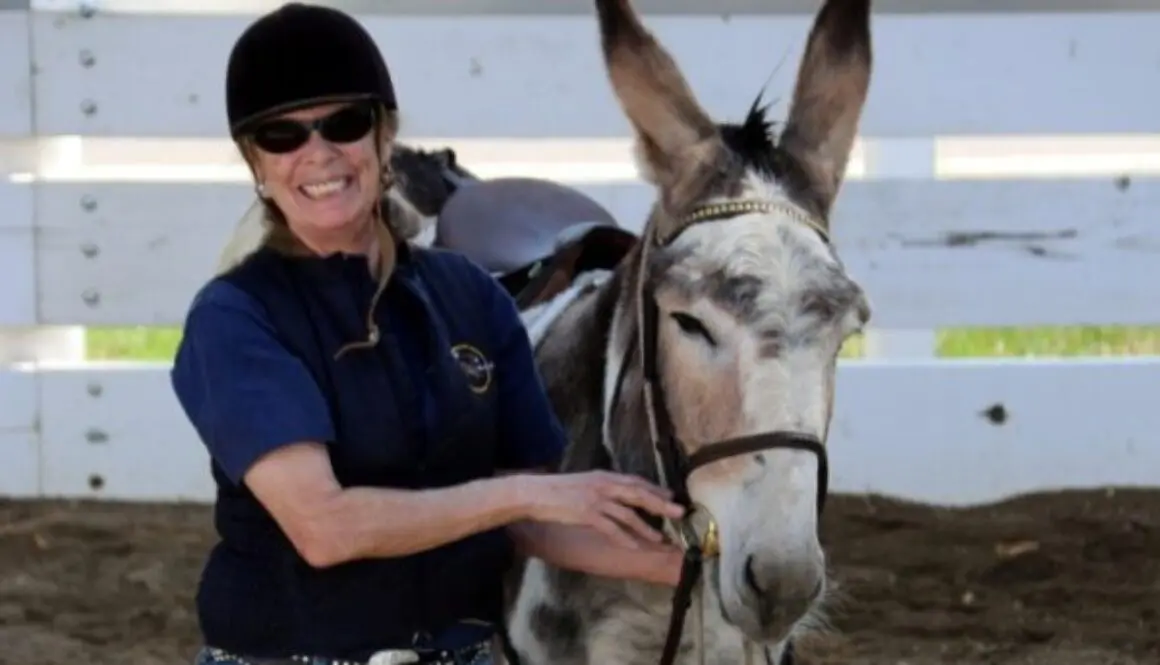
CHASITY’S CHALLENGES: Fine Tuning Chasity’s Response: 9-22-20
In the many years of the management and training of equines, I have learned how much the details really count! I learned about how much easier things can be when you are open minded and allow your education to grow. For instance, I learned how to train without the bit and bridle, but then learned that in doing so, I was not able to control postural development in the equine’s body. Thus, I invented my “Elbow Pull” as a response to Richard Shrake’s “Rhythm Collector.” I also found out that my “Elbow Pull” could be used in conjunction with the mild Eggbutt snaffle bit in a multitude of different ways, even for tying an animal. It is practically weightless and easily slips through the bit rings for optimum adjustment while the equine is in motion. It does need to be adjusted differently with horses, but the results are amazing as you can see with Chasity’s physical improvement.


Chasity’s huge cresty neck is practically gone now and the neck sweat has not been needed since she graduated to the Round Pen. This was because I have been repetitious in the way we execute ALL movements, even going through gates, in good equine posture! When we do this, Chasity uses ALL the muscles in her body to do these moves, and in this case, stretches across her spine to pull the Supraspinous ligament back into alignment while reducing the fatty tissues with efficient metabolic circulation. She is a lot more comfortable in her body, so standing quietly is no longer an issue.


Chasity has learned her verbal commands and responds promptly and quietly. Since donkeys do not freely exhibit as much energy as horses and mules, I only ask for five rotations at walk followed by five rotations at trot. As she is better able to keep her balance in good posture, the “Elbow Pull” remains loose, with very little tension throughout her whole workout.


Only now, instead of halting, resting and then changing direction, I do the whole exercise with a reverse in the middle for the change of direction. Her core is becoming more stable in her self-carriage. The muscles across her spine are becoming stronger and better able to support the weight of a rider.


She is relaxed, moves freely forward and most of the time halts four-square. Since she was a bit sticky with the reverse under saddle during her last lesson, I will add a step and ask for the reverse from the ground first.


Chasity understands what I mean and backs easily upon the command to “Back.” I then walk to the other end of the Round Pen and ask her to come to me with a verbal “Come,” also using hand signals. There is nothing more important than communicating clearly.


I politely ask Chasity to “Whoa,” with my hand put up like a “Stop” sign, and then mount her while she stands still. I pay special attention to lowering my seat slowly onto her back.


As I did in the Tack Barn when I first mounted her, I lean over to both sides and offer her reward of crimped oats for standing still, sit quietly in the saddle while she chews and then asked her to first rein back. I keep my contact VERY light, with an alternating squeeze/release from my little fingers on the reins, and a backward motion from my legs and seat.


When ready to go forward, I nudge her with my legs and then WAIT for her response. If she does not move right away, I nudge her again after waiting a few seconds. It will often take donkeys a little longer to THINK about what you are asking. It is far more productive to give them that time. Chasity walks off obediently and keeps her mind on her work as she passes Wrangler, waiting patiently for HIS turn!


I now add small circles randomly as we walk around the Round Pen. We pay special attention to staying erect and bending through the rib cage. I keep things slow, controlled and accurate.


We do “S” turns through the middle of the Round Pen to change direction. Speed can come later as the strength in good posture is developed and the connection to her bit remains light at all times.

I have discovered with this approach, there is hardly ever (if ever) any resistance or bad behaviors. Lessons go smoothly and safely for both of you. This is something I greatly appreciate with age!


Chasity maintains her good balance and cooperative attitude as we ride for about 15 minutes, practicing the circles, halts, “S” turns and reverses. Chasity comes to a “square” halt. I wait quietly for a few seconds.


Then I ask Chasity for a rein back and she complies easily…still light in the bridle. I dismount and tell her how pleased I am with her. I playfully massage her upper gums to illicit a smile! They like having their gums rubbed!


It was a very satisfying workout for us both! Chasity follows me as we exit the Round Pen and get ready for Wrangler’s turn! Allowing one animal to wait while another is worked, makes it easier to do the training. They seem to get support from their “Friends.” Occasionally working them alone as they gain confidence lets them know that being with you can always be fun and that you will always return them to their friends. This approach allows you to deepen the relationship between you, so you become as good a friend to them as their equine companions. This greatly eliminates the incidence of your equine becoming herdbound.



CHASITY’S CHALLENGES: Lunge Line Training: 7-21-20
Chasity is eager to go to the Round Pen and continue her lessons. Being polite, considerate, respectful and consistent in one’s approach will create a happy and willing partner. Most resistant behaviors arise from anxiety in the animal as a result of an unpredictable approach. Equines love the company of their own kind during training whenever possible. It gives them confidence, and a more experienced animal can show them how things are done with a compliant attitude. Breaking training down into very small steps assures that your equine will NEVER be over-faced with any tasks. It is paramount that you train your equine how to lunge on a lunge line for the first few times in the Round Pen.
Lunging in the “Elbow Pull” is critical to helping Chasity maintain her good posture and balance throughout her workout. It allows full range of motion, but will prevent any hollowing of the back and neck, and give her something to lean on when she has weak moments and cannot sustain her own good posture and self-carriage for a few strides at a time. Consistent work in the “Elbow Pull” will actually change the equine’s habitual way of moving. Chasity is becoming more and more comfortable in her new and more correct equine posture! This is most evident when she is at rest with equal weight placed over all four feet underneath her body. This is true whether at work or in turnout.
Chasity is now holding her own self-carriage in good posture for more and more strides during each new lesson. It takes a lot of time to stretch and rebuild the elements that support the skeletal frame such that the body becomes strong and movement becomes more flexible and habitual.
At walk and trot, Chasity and Wrangler maintain an erect body carriage and bend through their rib cages to the arc of the Round Pen circle. Wrangler can be a bit lazy and will carry his head too low, so I add the bridle reins to prevent him from becoming a “peanut roller!” Chasity carries her head higher, so she won’t need them.
After being warmed up with her familiar lunging of five rotations in each direction, I add the lunge line. I always keep it loose, dragging on the ground. Then I give an occasional “squeeze-release” as the outside front foot comes forward. This is her cue to stay on the circle later in the open arena and not pull on the lunge line.
My end goal is always to keep Chasity as light in the bridle as possible to get the desired response. Using all this gear in the beginning allows me to do minimal pulling on the lines and later the reins. The animal is in control of the adjustment of the tension. They learn quickly what I am asking with the lightest cue from my fingers.
Chasity is now comfortable and relaxed, knows what my cues mean. With the slightest pressure on the lines, she executes a lovely reverse and continues on in a really nice posture.
Being cognizant of how you do certain moves, like going through gates, will assure that the equine responds at all times with very SLIGHT pressure on the reins or lines, or even on the lead rope…no more BOLTING! You will never need to PULL on a lunge line again in any open areas. Loss of balance is the number one reason for resistance and bad behaviors. Building this precise foundation will carry through to Chasity’s under saddle work. Building core strength that symmetrically supports the skeletal frame makes everything you want to do a lot easier for your equine. When he is strong, balanced and comfortable in his body, he is better ABLE to be a willing and compliant companion!




